
Begonia is a genus of perennial flowering plants in the family Begoniaceae. The genus contains more than 2,000 different plant species. The Begonias are native to moist subtropical and tropical climates. Some species are commonly grown indoors as ornamental houseplants in cooler climates. In cooler climates some species are cultivated outside in summertime for their bright colorful flowers, which have sepals but no petals.
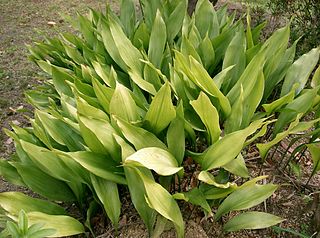
Aspidistra is a genus of flowering plants in the family Asparagaceae, subfamily Nolinoideae, native to eastern and southeastern Asia, particularly China and Vietnam. They grow in shade under trees and shrubs. Their leaves arise more or less directly from ground level, where their flowers also appear. The number of species known has increased considerably from the 1980s onwards, with around 100 accepted as of July 2013. Aspidistra elatior is common worldwide as a foliage house plant that is very tolerant of neglect. It and other species can also be grown in shade outside, where they are generally hardy to −5 °C (23 °F).

Hornbeams are hardwood trees in the plant genus Carpinus in the family Betulaceae. Its species occur across much of the temperate regions of the Northern Hemisphere.

Cathaya is a genus in the pine family, Pinaceae, with one known living species, Cathaya argyrophylla. Cathaya is a member of the subfamily Laricoideae, most closely related to Pseudotsuga and Larix. A second species, C. nanchuanensis, is now treated as a synonym, as it does not differ from C. argyrophylla in any characters.
The Nanling, also known as the Wuling, is a major mountain range in Southern China that separates the Pearl River Basin from the Yangtze Valley and serves as the dividing line between south and central subtropical zones. The main range of Nanling Mountains stretch west to east about 600 kilometers (370 mi) from Guilin and Hezhou of the eastern Guangxi to Ganzhou of the southern Jiangxi, north to south about 200 kilometres (120 mi) from Yongzhou and Chenzhou of the southern Hunan to Qingyuan and Shaoguan of the northern Guangdong; With their branches, the mountains run west to east 1,400 kilometers (870 mi).

Fangchenggang is a prefecture-level city in the south of Guangxi Zhuang Autonomous Region, People's Republic of China. The city was formerly called "Fangcheng Pan-Ethnicities Autonomous County".

The genus Helwingia consists of shrubs or rarely small trees native to eastern Asia, the Himalayas, and northern Indochina. It is the only genus in the family Helwingiaceae.
Begonia cavaleriei is a species of plant in the family Begoniaceae. It is endemic to China. It grows on limestone rocks.
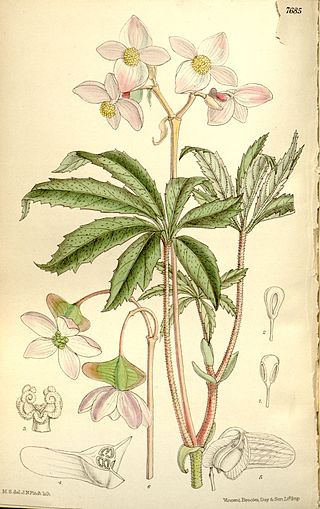
Begonia hemsleyana is a species of plant in the family Begoniaceae. It is a rhizomatous geophyte native to southwestern Guangxi and southeastern Yunnan in southern China, and to Laos, Myanmar, and Vietnam in northern Indochina.
Begonia peltatifolia is a species of plant in the family Begoniaceae. It is endemic to China. It grows on limestone rocks and broad-leaved forests.
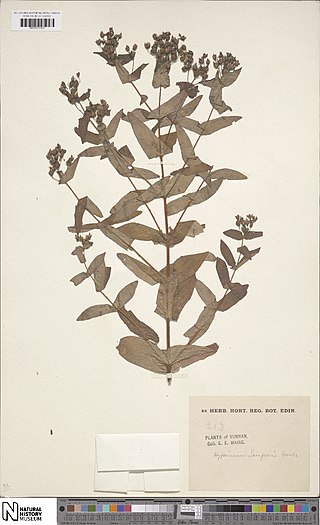
Hypericum sampsonii is a species of flowering plant in the St. John's wort family, Hypericaceae. It occurs in China, Taiwan, Japan, Myanmar, and Vietnam. It is one of two species of Hypericum in the section Hypericum sect. Sampsonia.
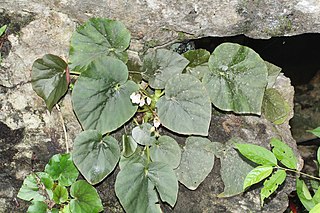
Begonia elnidoensis is an endemic species of Begonia discovered in El Nido, Palawan, Philippines. The species was compared to Begonia wadei, in that both species have thick-trunked stem, differing in the widely to very widely ovate or subtriangular leaves, with the latter having obliquely ovate leaves, 3-4 secondary leaf veins where the latter has 6 on each side of the midrib, with glabrous petioles compared to latter having puberulous to tomentose, an inflorescence measuring 20–40 cm in length compared to only 6–20 cm, and the differently-sized bracts and capsules.
Begonia balangcodiae is an endemic species of Begonia discovered in Sagubo, Kapangan, Benguet, Philippines. The species was allied to B. esculenta Merr., from which it is distinguished by its cordate leaf base and white tepals, while the latter's leaf base is not cordate and has a vermilion-colored tepals. On the same hand, this species resembles that of B. leucosticta Warburg, differing from the latter on cordate leaf base versus subcordate leaf base, and larger tepals ranging in size from 12 to 18 mm long in pistillate flowers versus the latter's 3–5 mm. Additionally, this species is similar to B. negrosensis Elmer, in that it has lanceolate, glabrous leaf compared to that of latter's obovately oblong and sparsely hairy leaves, and white to greenish tepals, versus that of latter's pinkish tepals.
Begonia gironellae is an endemic species of Begonia discovered in Tanabag, Puerto Princesa, in northern Palawan, Philippines. The species resembled Begonia cleopatrae, in that both species have widely ovate, variegated leaves, and fleshy hairs fused into a ring at the base of the leaf petiole. However, Begonia gironellae differed from B. cleopatrae due to its rosette habit with rhizome shorter to 5 cm long, with very congested internodes, widely triangular stipules, differently-sized lamina and bracts, and capsule with wider abaxial wing. Additionally, B. gironellae is a lowland species occurring in broadleaved seaside forests, while B. cleopatrae grows on hill forest at ca. 400m.

Begonia longiciliata is a species of flowering plant in the family Begoniaceae, found in Laos and Vietnam, and Yunnan, Guizhou, Guangxi provinces of China. It is popular in cultivation.
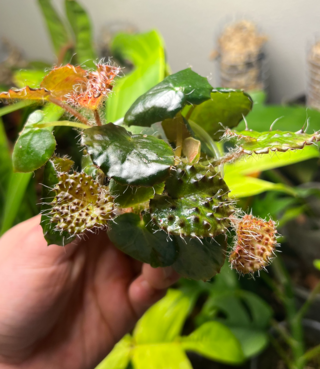
Begonia ferox is a species of flowering plant in the family Begoniaceae. Begonia ferox has been documented in Guangxi Zhuangzu growing on limestone outcroppings of the forest floor. It has a creeping growth habit, with leaves up to 19 cm long and 13 cm wide. When the leaves reach maturity, blackish-brown and hairy bullae with red tips emerge, up to 1.3 cm tall and .6 cm wide. It flowers from January through May, producing fruit April through July. Carpellate flowers are pinkish white, while staminate flowers are pinkish yellow, and the fruit is reddish-green.
Begonia amphioxus is a species of flowering plant in the family Begoniaceae, section Petermannia, native to Sabah state, Malaysia. There it is found growing in light shade on limestone, either at the base of cliffs or on top of outcrops. A shrub reaching 40 cm (16 in), its upright peltate leaves are 5 to 12 cm long, lance-shaped and pointed at both ends. The highly ornamental leaves are olive to mid-green, with red spots and a red border around the margin.
Begonia baik is a species of flowering plant in the family Begoniaceae, native to Borneo. A creeping to sub-erect perennial with maroon to dark green rugose leaves, it is found growing at the base of sandstone cliffs or on earthy slopes.

Begonia luzhaiensis is a species of Begonia found in Guangxi, China.











